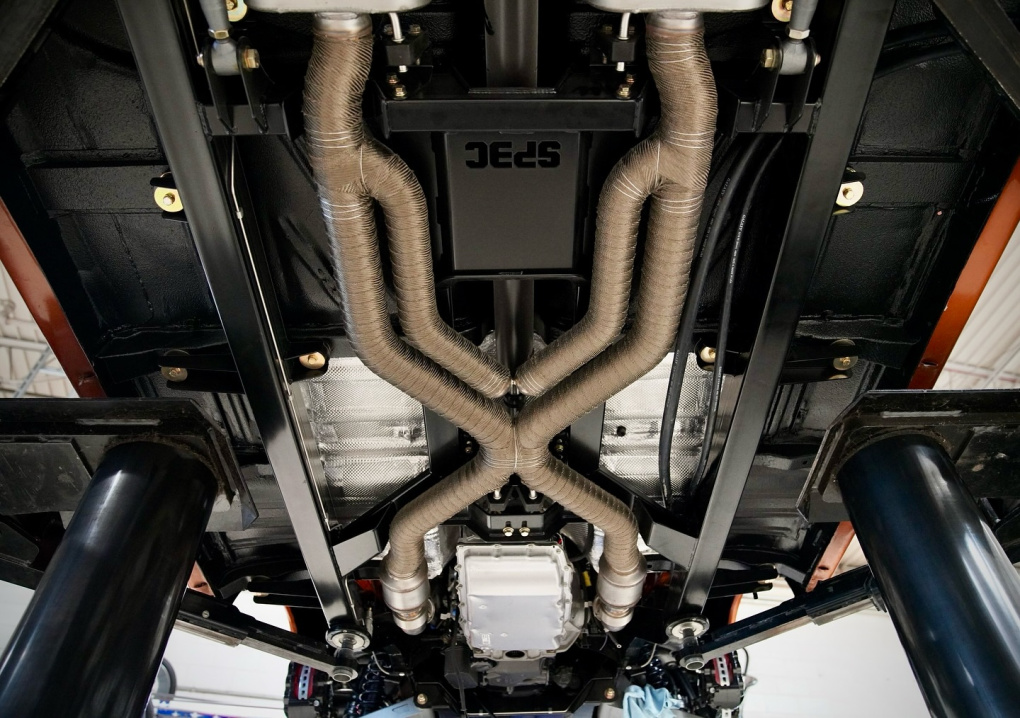
What is exhaust wrap? How many meters do I need?
How many meters of exhaust wrap do I need? Calculate it below!
* The length is an estimate and does not take bends into account.
What is exhaust wrap?
Exhaust wrap is a recommended part in tuned cars or when driving hard, designed to insulate the exhaust pipes and reduce heat radiation to nearby components such as fuel lines and other heat-sensitive parts in the engine compartment.
Exhaust wrap is available in various widths, lengths and colours and can be made from a variety of materials such as titanium, which can withstand high temperatures. Its use helps to maintain the temperature of the exhaust gases, which can increase engine performance in both naturally aspirated and turbocharged engines. This is particularly useful around manifolds and exhaust pipes to increase exhaust flow and reduce the risk of fire in the engine compartment. The DEI Exhaust Wrap is a good example of insulating exhaust components, such as downpipes and exhaust systems, to maintain the temperature of the exhaust gases and protect nearby components from heat radiation. These components have a temperature range of up to 800°C continuously and up to 1100°C during hard driving, thus protecting other components from the heat.

How to wrap manifolds, downpipes and exhaust systems?
To wrap manifolds, downpipes, and exhaust systems with exhaust wrap, follow these steps for best results:
-
Preparation:
- Wear protective gloves and ensure you have enough exhaust wrap.
- Soak the exhaust wrap in warm water to make it more pliable and easier to work with.
-
Winding process:
- Start by wrapping the heat shield material tightly and evenly around the exhaust parts. Make sure to overlap the wrap by at least half its width for even insulation.
- Use stainless steel cable ties to secure the heat shield at each end, ensuring a tight fit.
- For DEI Exhaust Wrap, secure the wrap with stainless steel clips at each end or joint, ensuring the wrap conforms to the shape of the component. Each layer of DEI Exhaust Wrap should overlap by approximately 5mm.
-
Finishing:
- Let the exhaust wrap dry and then impregnate with a heat-resistant silicone spray to improve its durability and water resistance.
- Correct installation is crucial to the effectiveness and lifespan of the heat shield.
How much exhaust wrap is needed?
Choosing the right amount of exhaust wrap can be crucial to protecting your vehicle from overheating and minimizing damage. But how much do you really need? Here we will give you recommended lengths for 50 mm wide exhaust wrap.
50 mm wide exhaust wrap with 50% overlap
- 3" pipes that are approximately 60 cm long (for example a downpipe) need at least 6 meters of exhaust wrap to cover the entire pipe.
- 2.5" pipes that are approximately 90 cm long (for example a manifold) need at least 7.5 meters of exhaust wrap to cover a pipe from the cylinder.
If you think 50% overlap is too much, you can always go around 33-25% for more length but with less heat protection.
- With a 33% overlap on a 2.5" pipe that is approximately 90 cm long, you will need at least 5.5 meters
- With a 25% overlap on a 2.5" pipe that is approximately 90 cm long, you will need at least 4.9 meters
Remember that more overlap means better heat protection and durability. So if you want extra protection, you can increase the overlap on the exhaust wrap.
Would you like to learn how to calculate the length needed when wrapping with an exhaust wrap? Then visit our calculator at the top of the page.
How much overlap should I have?
When wrapping exhaust wrap, it is important to use the correct overlap. The overlap, which can vary between 25% and 75%, affects the quality of the insulation and the material consumption.
Straight parts
When winding straight pipes, the overlap is not as critical as with bends, but it still affects the insulation and material consumption. If you want better insulation, you can use 75% overlap. However, if you want to minimize material consumption, you can settle for 25% overlap.
Bends
When winding bends, the overlap is crucial to avoid unnecessary thickness of the winding. On the outside of the pipe bend, approximately 25% overlap is recommended to keep the thickness at a reasonable level. The inside overlap is automatically affected by the angle of the bend and does not need to be adjusted separately.
Conclusion
Wrapping with exhaust wrap offers a range of benefits, from reduced heat radiation to improved performance and durability. By selecting and correctly applying exhaust wrap around parts of the exhaust system that are close to the engine, you reduce the risk of overheating while protecting the engine compartment from unnecessary heat.
Avoiding common mistakes and following recommended maintenance will ensure that you get the most out of your exhaust wrap. Finally, the value of applying this knowledge to protect your vehicle cannot be overstated, making the information in this article essential for anyone considering or installing exhaust wrap.
FAQs
How to wrap exhaust wrap correctly?
To wrap exhausts properly, you should follow these steps:
- Make sure you have enough exhaust wrap.
- Use two metal cable ties to secure the wrap at both ends.
- Use gloves to protect your hands.
- Apply rust protection to the pipes before you start wrapping.
- Wet the bandage before wrapping for better adaptation.
- Wrap tightly around the pipe.
- Start the engine to dry the bandage after wrapping.
- Spray impregnation with a suitable silicone spray for extra protection.
Why should you use exhaust wrap?
Exhaust wrap is used to insulate manifolds, downpipes and exhaust systems in vehicles. The purpose is twofold:
- To protect other parts of the vehicle from radiant heat that could cause damage or impact.
- To reduce the temperature in the engine compartment and thereby improve vehicle performance.
Senast uppdaterad:
Publicerad:

.jpg)

.jpeg)
.jpeg)
